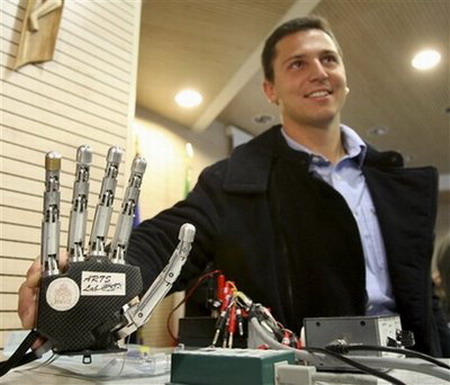highlights
Experts: Man controlled robotic hand with thoughts
(Agencies)
Updated: 2009-12-03 10:29
|
 Amputee Pierpaolo Petruzziello touches a robotic hand during a press conference in Rome, Wednesday, December 2, 2009. [Agencies] |
Experts around the world have developed other thought-controlled prostheses. One approach used in the United States involves surgery to graft shoulder nerves onto pectoral muscles and then learning to use those muscles to control a bionic arm.
While that approach is necessary when the whole arm has been lost, if a stump survives doctors could opt for the less invasive method proposed by the Italians, connecting the prosthesis to the same system the brain uses to send and receive signals.
It will take at least two or three years before scientists try to replicate the experiment with a more long-term prosthesis, the experts said. First they need to study if the hair-thin electrodes can be kept in longer.
Results from the experiment are encouraging, as the electrodes removed from Petruzziello showed no damage and could well stay in longer, said Klaus-Peter Hoffmann, a biomedical expert at the Fraunhofer-Gesellschaft, the German research institute that developed the electrodes.
More must also be done to miniaturize the technology on the arm and the bulky machines that translate neural and digital signals between the robot and the patient.
Key steps forward are already being made, Rossini said. While working with Petruzziello, the Italian scientists also were collaborating on a parallel EU-funded project called "SmartHand," which has developed a robotic arm that can be directly implanted on the patient.











